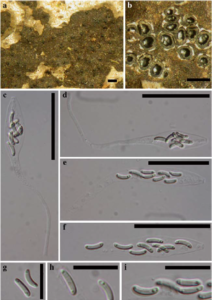Diatrype palmicola J.K. Liu & K.D. Hyde, in Liu et al., Fungal Diversity: 10.1007/s13225-015-0324-y, [23] (2015)
Index Fungorum number: IF551017; Facesoffungi number: FoF00487, Fig. 1
Etymology − Named after the host on which the fungus was collected.
Holotype − MFLU 15-0040
Saprobic on palm fronds. Stromata well-developed, or comprising mostly fungal tissue, often delimited with a black line perceptible in the wood below, bursting through bark or wood and often surrounded by remaining adherent epidermis or wood fragments, discoid to pulvinate or hemisphaerical, generally strongly emerged from the host surface. Entostroma poorly developed between ascomata, only present at the level of the neck. Sexual morph Ascomata immersed in the stromata, with the stromata surface flat or slightly convex. Ostiole flattened and circular or subconical. Asci 70–110×7– 9μm, 8–spored, unitunicate, long pedicellate, clavate, apically rounded to truncate. Ascospores (6−)7–8(−9)×1.5–2μm, 2–3 seriate, allantoid, 1–celled, hyaline to subhyaline, rarely pale olivaceous, slightly to moderately curved and smooth-walled.
Material examined − THAILAND, Chiang Rai Province, Muang District, Khun Korn Waterfall, on dead branch of Caryota urens L. (Arecaceae), 14 March 2010. J.K. Lui, JKA0031 (MFLU 15-0040, holotype) ex-type living culture= MFLUCC 11–0018; ibid. on dead branch of Caryota urens, 6 September 2010, J.K. Liu, JKA0032 (MFLU 15-0041, paratype); living culture, MFLUCC 11– 0020.
GenBank Accession Numbers − MFLUCC 11–0018 – ITS: KP744438; LSU: KP744481; SSU: KP753949; MFLUCC 11– 0020 – ITS: KP744439; LSU: KP744482; SSU: KP753950.
Notes − Diatrype palmicola has morphological characteristics typical of taxa in the genus Diatrype. Four species, namely D. euterpes, D. palmarum, D. palmarum var. rimosa and D. urticaria are described from palms (Liu et al. 2014). Analyses showed that D. palmicola ITS sequences differ from all sequences of taxa of Diatrype in GenBank, including the close species D. favacea and D. pulvinata. The reconstruction generated from ITS sequences showed similar results as previous studies (Acero et al. 2004; Trouillas et al. 2011). This suggests that the current taxonomic scheme for the Diatrypaceae may not reflect the true phylogenetic relationship of these fungi. The number of spores per ascus (eight spores versus more than eight spores) has been used traditionally to define genera of Diatrypaceae (Diatrype vs. Diatrypella and Eutype vs. Eutypella). However the polysporous ascus feature has been shown to be not significant in Diatrypaceae based on recent studies (Acero et al. 2004; Vasilyeva and Stephenson 2005; Trouillas et al. 2011; Chacon et al. 2013) and the phylogenies showed that the genera Cryptovalsa and Eutypella, as well as Diatrype and Diatrypella have molecular affinities. Until more species are collected, epitypified and sequenced, as well as an increased sampling of taxa included, the understanding of Diatrypaceae will remain fragmentary.

Fig. 1 Diatrype palmicola (holotype). a, b Appearance of the stromata on host surface c–f Asci with long pedicels g-i Allantoid ascospores. Scale Bars: a, b=1 mm. c–f=30μm, g–i= 10μm.
